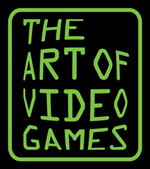
The Museum of Modern Art (MoMA) is an art museum located in Midtown Manhattan, New York City, on 53rd Street between Fifth and Sixth Avenues. The institution was conceived in 1929 by Abby Aldrich Rockefeller, Lillie P. Bliss, and Mary Quinn Sullivan. Initially located in the Heckscher Building on Fifth Avenue, it opened just days after the Wall Street Crash. The museum, America's first devoted exclusively to modern art, was led by A. Conger Goodyear as president and Abby Rockefeller as treasurer, with Alfred H. Barr Jr. as its first director. Under Barr's leadership, the museum's collection rapidly expanded, beginning with an inaugural exhibition of works by European modernists. Despite financial challenges, including opposition from John D. Rockefeller Jr., the museum moved to several temporary locations in its early years, and John D. Rockefeller Jr. eventually donated the land for its permanent site.

Katamari Damacy is a third-person puzzle-action video game developed and published by Namco for the PlayStation 2. It was released in Japan in March 2004 and later in North America in September. Designer Keita Takahashi struggled to pitch the game to Namco's superiors, eventually seeking student aid from the Namco Digital Hollywood Game Laboratory to develop the project for less than US$ 1 million. As director, Takahashi emphasized concepts of novelty, ease of understanding, and enjoyment.

Pac-Attack, also known as Pac-Panic, is a 1993 falling-tile puzzle video game developed and published by Namco for the Super Nintendo Entertainment System and Sega Genesis. Versions for the Game Boy, Game Gear and Philips CD-i were also released. The player is tasked with clearing out blocks and ghosts without them stacking to the top of the playfield — blocks can be cleared by matching them in horizontal rows, while ghosts can be cleared by placing down a Pac-Man piece that can eat them. It is the first game in the Pac-Man series to be released exclusively for home platforms.

Keita Takahashi is a Japanese game designer and artist, his most notable titles being Katamari Damacy and its sequel, We Love Katamari. The original Katamari game was a surprise hit and was praised for its quirkiness, originality, and charm. Takahashi is married to pianist and composer Asuka Sakai, who has worked with Takahashi on various projects.
Yuu Miyake is a Japanese composer and sound engineer who formerly worked at Bandai Namco Entertainment. His most known work surfaced with Katamari Damacy soundtracks, on which he served as a sound director. Other notable works include various tracks in the Tekken and Ridge Racer series.

Paola Antonelli is an Italian architect, curator, author, editor, and educator. Antonelli is the Senior Curator of Architecture and Design at the Museum of Modern Art (MoMA), New York, where she also serves as the founding Director of Research and Development. She has been described as "one of the 25 most incisive design visionaries in the world" by TIME magazine.
Dunne & Raby is a London-based design studio established 1994.

Game On is a touring exhibition on the history and culture of computer games. The exhibition was first shown at the Barbican Centre in London in 2002, and has since been exhibited by Barbican International Enterprises to over 20 countries, where it has been seen by over 2 million people.

I Love Katamari was a third-person puzzle-action video game developed by Namco Bandai Games for iOS. It is a continuation of the Katamari Damacy series of games. It was released worldwide in the App Store on December 14, 2008. A Windows Phone 7 version of the game was released in 2010. The version for Android was released in 2012 exclusively for Samsung Android devices. In this game, the King of All Cosmos instructs the game's protagonist – the Prince – to gather as many objects as possible to grow a highly adhesive ball called a Katamari large enough so that he can pick up special objects to bring to the King so that he can regain his memory.
Katamari Damacy is a third-person puzzle-action video game that was published and developed by Namco for the PlayStation 2 video game console. The success of the game led to the release of six sequels in Japan and other territories: We Love Katamari, Me & My Katamari, Beautiful Katamari, Katamari Damacy Mobile, I Love Katamari, and Katamari Forever. It also inspired a spin-off game, Korogashi Puzzle Katamari Damacy.
Passage is a 2007 experimental video game developed by Jason Rohrer. Since its release it has become a significant entry in the burgeoning debate of video games as an art form. Rohrer himself has been an outspoken proponent of advancing the artistic integrity of the medium.

The Art of Video Games was an exhibition by the Smithsonian American Art Museum which was on display March 16–September 30, 2012. The exhibition was designed to highlight the evolution of art within the video game medium over its forty-year history. Following its time at the Smithsonian American Art Museum, the exhibition toured to 10 additional venues in the United States. Chris Melissinos, founder of Past Pixels and collector of video games and gaming systems, was the curator of the exhibition.
Talk to Me: Design and the Communication between People and Objects is an exhibition put on by the Museum of Modern Art from July 24 to November 7, 2011. Created by the Department of Architecture and Design, it was widely reviewed and drew many visitors. The exhibit was organized by Paola Antonelli, Senior Curator in the Department of Architecture and Kate Carmody, curatorial assistant. The exhibition explores and showcases the communications, dialogue and interface between people and machines.

Katamari Amore was a third-person puzzle-action video game published and developed by Namco Bandai Games for iOS. The game was revealed in a pre-release state at E3 2011, and was released to the public on September 29. Katamari Amore is the second game of the Katamari franchise to be released on iOS, and it featured Game Center integration.
Standard Deviations was the name of a Museum of Modern Art exhibition that was notable for showcasing the 23 digital typefaces that MoMA acquired in January 2011 for its Architecture and Design Collection. The exhibition was open from March 2, 2011 through January 30, 2012. The full title of the exhibition was Standard Deviations: Types and Families in Contemporary Design, though the title was originally announced as Standard Deviations: Prototypes, Archetypes, and Families in Contemporary Design. The exhibition was organized by Paola Antonelli, Senior Curator in the Department of Architecture and Kate Carmody, curatorial assistant.
Jacolby Satterwhite is an American contemporary artist who creates immersive installations. He has exhibited work at the Minneapolis Institute of Art, the Museum of Contemporary Art, Chicago, Louis Vuitton Foundation in Paris, the New Museum and the Museum of Modern Art, both in New York City, and the Institute of Contemporary Art, Philadelphia. In addition to MoMA, his work is in the public collections of the Studio Museum in Harlem, the Seattle Art Museum, the Whitney Museum of American Art, the Kiasma, and the San Jose Museum of Art. Satterwhite has also served as a contributing director for the music video that accompanied Solange's 2019 visual album When I Get Home and directed a short film accompaniment to Perfume Genius's 2022 studio album Ugly Season.

Laura Kurgan is a South African architect and an associate professor at Columbia University Graduate School of Architecture, Planning and Preservation (GSAPP). She directs the interdisciplinary Center for Spatial Research at GSAPP, which she founded as the Spatial Information Design Lab in 2004. Since 1995, the architect has operated her own New York City based interdisciplinary design firm called Laura Kurgan Design. She has been awarded the Rockefeller Fellowship and a Graham Foundation Grant. Kurgan's work has been presented at prestigious institutions including the ZKM Karlsruhe, the Museum of Modern Art, the New Museum and the Venice Architecture Biennial.

Michael Benabib is an American portrait photographer, known for his portraits of David Bowie, Tupac Shakur, Sean Combs, and Keith Richards among others. Notable portrait photography of public figures include Bill Clinton, Alan Dershowitz and Loretta Lynch. His work has appeared in publications including Vanity Fair, Vogue, GQ, Rolling Stone, Vibe, ESPN magazine, The Wall Street Journal, The New York Times, NPR and Newsweek. His work was included to photography collections on display by The Smithsonian and MoMa.

Nathalie Lawhead is an independent net artist and video game designer residing in Irvine, California.












